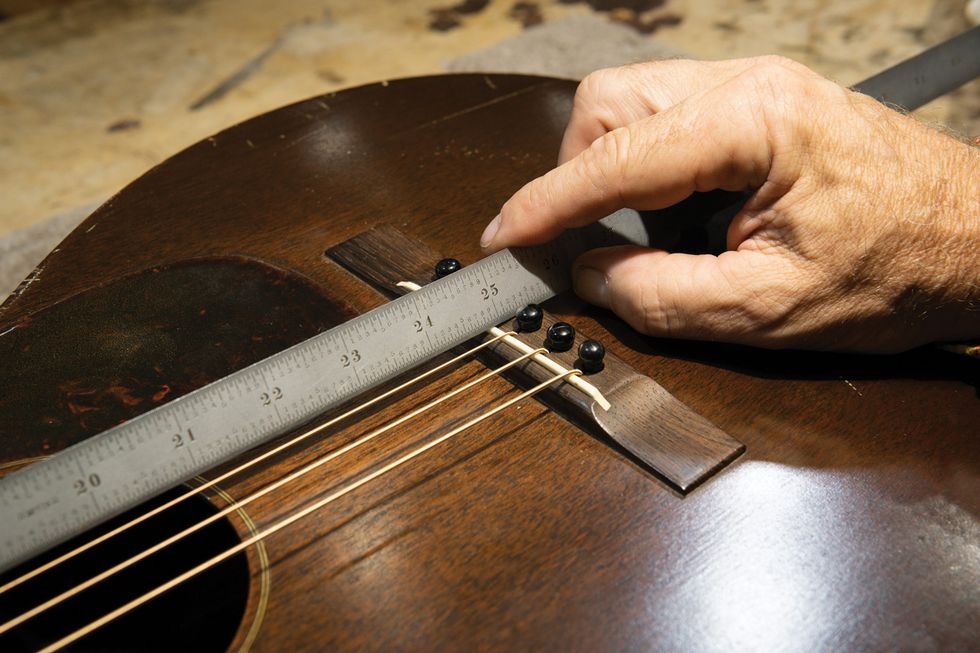Scale length can be a confusing topic. It’s commonly known that some guitars have shorter scales while others have longer scales, or, in other words, frets are closer together on some guitars and further apart on others. What the debate seems to be is how this impacts a guitar’s tone, response, and playability.
Players often dismiss short-scale guitars because they feel they might not be as powerful as long-scale models. The truth is that I have encountered plenty of short-scale guitars that were incredibly loud, and long-scale models that were not. Over time, I’ve perceived that it’s actually more of a type of tone issue rather than power. Vocalists, for example, might prefer short-scale instruments for their open, relaxed tone, while soloists tend to gravitate toward long-scale instruments for their authoritative and defined sound.
In relation to what impacts these things the most, the scale length is a secondary issue to the string length. It’s the tension created by the total string length being tuned to pitch and the tension placed on the soundboard that defines the tone, response, and feel of the instrument. On a 25.5"-scale instrument strung with standard medium-gauge strings, the tension created is around 189 pounds. A shorter-scale instrument strung with the same medium-gauge strings has approximately six pounds less string tension pulling on the soundboard. This directly affects the tone and response of the instrument enough that most players can hear and feel the difference.
In the early days of stringed instruments, even the ones that were plucked did not have frets. The players themselves brought an instrument into pitch by finger placement on the fingerboard. Over time, instrument makers developed the “Rule of 18,” an equation that located the correct positions to play in tune, which laid the groundwork for fret placement.
And when frets were added to the already established string lengths, modern fretted instruments were born. Today, we have adjusted the Rule of 18 to sweeten the scale, and, along with some creative nut placement and saddle adjustments, modern instruments play much more in tune than their predecessors.
Traditional classical guitars had measurements of 640 mm, 650 mm, or 660 mm, and many instrument makers that migrated to the U.S. also calibrated by these metric measurements and guidelines. Over time, companies such as the Gibson Mandolin-Guitar Mfg. Co. used imperial standard measurement, which accounts for their 24.75" and 25.5" scale lengths. The Martin Guitar Co., on the other hand, likely advertised their instruments by string length rather than scale, which explains their 24.9" and 25.4" short and long measurements. I have measured many “untouched” vintage Martins and their short scale, for example, measures around 24.75" with a string length of 24.9". The reason for the longer string length is to accommodate for string action that pushes the saddle back, thereby keeping the instrument from playing sharp. This is true on all fretted instruments: Even Gibson’s instruments will measure around .125" longer than the advertised scale length.
Photo 2
Tip: If you want to find the actual scale length of any guitar, simply measure from the leading edge of the nut to the 12th fret (Photo 1), and then multiply that by two. If you measure from the leading edge of the nut to the center of the saddle between the 3rd and 4th strings (Photo 2), this is the string length. Of course, the saddle angles back as it moves toward the 6th string, which accommodates for string diameter.
With both longer and shorter scales, there are always trade-offs. This is why many custom-guitar builders have incorporated multi-scales (aka fanned frets) into the list of options for their customers. The most popular configuration is 26" on the bass side and 25" on the treble side, which effectively bridges the gap between longer and shorter scales. Performers who tune to DADGAD or other alternative tunings like fanned frets because they help prevent the low end from getting loose, which can cause the notes to become undefined and buzz. Meanwhile, the high-end tension drops into the range of a Gibson short-scale, thereby offering the sweet high end so many players like.
Matching the scale length to your playing style is one of those factors that’s subjective, although it is common that certain music styles do gravitate toward one scale length. I personally have scales that range from 24.75" all the way up to a 28.75" baritone. My current go-to guitar is, of course, one of my 25.5" scale G.2C models, but that could change at any moment. I’ll keep you posted.




















